Urban Spatial Image Acquisition and Examination Based on Geographic Big Data
Abstract
:1. Introduction
1.1. Research Background and Progress
1.2. The Main Goal of the Paper
2. Materials and Methods
2.1. Description of Study Area
2.2. Source of Data
2.3. Methods
2.3.1. Fishnet Analysis
2.3.2. Kernel Density Estimation
2.3.3. Analysis of the POI Function Category
2.3.4. Mixing Degree of the POI Function
2.3.5. Research Framework
- (1)
- Using buildings as the descriptive element of spatial form, the basic form of architectural space was analyzed through architectural indicators.
- (2)
- Using POIs as the descriptive element of spatial service, the spatial function category was obtained through index calculation and analysis.
- (3)
- Through the joint analysis and statistics of the two groups of categories, a unique urban spatial image map of the main urban area of Zhengzhou was obtained, which described the spatial form and function of the study area in the form of different elements.
3. Results
3.1. Analysis of Urban Spatial Form Based on Buildings
3.1.1. Fishnet Analysis of Main Urban Buildings
3.1.2. Category and Distribution of Architectural Spatial Form
- (a)
- For a smaller number of types, filtering those that do not show prominent spatial characteristics, excluding them, and merging the rest with adjacent categories.
- (b)
- Carrying out secondary merging on the processed date (a), viewing differences between the three indicators of different types and the similarity of their spatial distribution characteristics, and selecting the types with high similarities for merging. Finally, the architectural form category of Zhengzhou City is obtained (Figure 7).
3.2. Analysis of Urban Spatial Service Based on POIs
3.2.1. Results of POI Kernel Density Analysis
3.2.2. Category and Structure of POI Spatial Service Functions
3.3. The Urban Space Image Results
3.3.1. Joint Analysis of Architectural Spatial Form and POI Spatial Service
3.3.2. Recognition and Expression of Spatial Image Elements
- (1)
- Annular layer element
- (2)
- Functional landmark element
- (3)
- Ring boundary element
- (4)
- Special regional elements
3.4. Inspection Based on City Planning Documents
- (1)
- Two main centers
- (2)
- Five sub-centers
- (3)
- Third Ring Road
- (4)
- Four special regions and eight districts
4. Discussion
4.1. Continuation and Development of Lynch’s City Image Theory
4.2. Differences from Traditional Image Results
4.3. Application of Image Research Results in Urban Development
4.4. Contributions and Limitations of the Research
5. Conclusions
Author Contributions
Funding
Data Availability Statement
Conflicts of Interest
References
- Guan, X.; Wei, H.; Lu, S.; Dai, Q.; Su, H. Assessment on the urbanization strategy in China: Achievements, challenges and reflections. Habitat Int. 2018, 71, 97–109. [Google Scholar] [CrossRef]
- Zhao, L.; Luo, L.; Li, B.; Li, H. Analysis of the Uniqueness and Similarity of City Landscapes Based on Deep Style Learning. ISPRS Int. J. Geo-Inf. 2021, 10, 734. [Google Scholar] [CrossRef]
- Shi, Y.; Zhai, G.; Xu, L.; Zhou, S.; Lu, Y.; Liu, H.; Huang, W. Assessment methods of urban system resilience: From the perspective of complex adaptive system theory—ScienceDirect. Cities 2021, 112, 103141. [Google Scholar] [CrossRef]
- Faria, P.; Ferreira, F.; Jalali, M.S.; Bento, P.; António, N. Combining cognitive mapping and MCDA for improving quality of life in urban areas. Cities 2018, 78, 116–127. [Google Scholar] [CrossRef]
- Zhang, A.; Li, W.; Wu, J.; Lin, J.; Chu, J.; Xia, C. How can the urban landscape affect urban vitality at the street block level? A case study of 15 metropolises in China. Environ. Plan. B Urban Anal. City Sci. 2021, 48, 1245–1262. [Google Scholar] [CrossRef]
- Feng, J. Spatial cognition and image space of Beijing’s residents. Sci. Geogr. Sin. 2005, 2, 142–154. [Google Scholar] [CrossRef]
- Cao, Y.; Long, Y.; Yang, P. City image study based on online pictures: 24 cities case. Planners 2017, 33, 61–67. [Google Scholar]
- Lynch, K. The Image of the City; MIT Press: Cambridge, MA, USA, 1960. [Google Scholar]
- Yang, Z.; Yin, M.; Xu, J.; Lin, W. Spatial evolution model of tourist destinations based on complex adaptive system theory: A case study of Southern Anhui, China. J. Geogr. Sci. 2019, 29, 1411–1434. [Google Scholar] [CrossRef]
- Zhou, X.; Li, H.; Zhang, H.; Zhang, R.; Li, H. A Study on the Cognition of Urban Spatial Image at Community Scale: A Case Study of Jinghu Community in Zhengzhou City. Land 2022, 11, 1654. [Google Scholar] [CrossRef]
- Zhao, Z.; Song, J.; Liang, S.; Yan, T. Campus image space analysis and comprehensive cognitive level measurement: A case study of Nanjing University of Information Science and Technology. Reg. Res. Dev. 2022, 41, 77–83. [Google Scholar]
- Gu, C.; Song, G. Urban image space and main factors in Beijing. Acta Geogr. Sin. 2001, 56, 64–74. [Google Scholar]
- He, D.; Dan, C.; Zhang, P.; Gao, P. Spatial scope cognition of urban agglomeration in the middle reaches of Yangtze River based on cognitive map of college students. Geogr. Res. 2018, 37, 1818–1831. [Google Scholar]
- Huang, J.; Obracht-Prondzynska, H.; Kamrowska-Zaluska, D.; Sun, Y.; Li, L. The image of the City on social media: A comparative study using “Big Data” and “Small Data” methods in the Tri-City Region in Poland. Landsc. Urban Plan. 2021, 206, 103977. [Google Scholar] [CrossRef]
- Mccunn, L.J.; Gifford, R. Place imageability, sense of place, and spatial navigation: A community investigation. Cities 2021, 115, 103245. [Google Scholar] [CrossRef]
- Dai, T.; Zheng, X. Understanding how multi-sensory spatial experience influences atmosphere, affective city image and behavioural intention. Environ. Impact Assess. Rev. 2021, 89, 106595. [Google Scholar] [CrossRef]
- Vanderhaegen, S.; Canters, F. Mapping urban form and function at city block level using spatial metrics. Landsc. Urban Plan. 2017, 167, 399–409. [Google Scholar] [CrossRef]
- Harvey, C.; Aultmanhall, L.; Troy, A.; Hurley, S.E. Streetscape skeleton measurement and classification. Environ. Plan. B. Urban Anal. City Sci. 2017, 44, 668–692. [Google Scholar] [CrossRef]
- Middel, A.; Lukasczyk, J.; Zakrzewski, S. Urban form and composition of street canyons: A human-centric big data and deep learning approach. Landsc. Urban Plan. 2018, 183, 122–132. [Google Scholar] [CrossRef]
- Ye, Y.; Jia, C. Research on the Influence of pedestrian space Characteristics on physical disorder in living streets of old city Based on Street View Image—A case study on theANN area of Harbin. Contemp. Archit. 2022, 35, 72–75. [Google Scholar]
- Chen, Z.; Yu, B.; Wei, S.; Liu, H.; Wu, J. A New Approach for Detecting Urban Centers and Their Spatial Structure with Nighttime Light Remote Sensing. IEEE Trans. Geosci. Remote Sens. 2017, 55, 6305–6319. [Google Scholar] [CrossRef]
- Agustí, D. The clustering of city images on Instagram: A comparison between projected and perceived images. J. Destin. Mark. Manag. 2021, 20, 100608. [Google Scholar] [CrossRef]
- Peng, X.; Bao, Y.; Huang, Z. Perceiving Beijing’ s “City Image” Across Different Groups Based on Geotagged Social Media Data. IEEE Access 2020, 8, 93868–93881. [Google Scholar] [CrossRef]
- Yao, Y.; Wang, J.; Hong, Y.; Qian, C.; Guan, Q.; Liang, X.; Dai, L.; Zhang, J. Discovering the homogeneous geographic domain of human perceptions from street view images. Landsc. Urban Plan. 2021, 212, 104125. [Google Scholar] [CrossRef]
- Yao, Y.; Liang, Z.; Yuan, Z.; Liu, P.; Bie, Y.; Zhang, J.; Wang, R.; Wang, J.; Guan, Q. A human-machine adversarial scoring framework for urban perception assessment using street-view images. Int. J. Geogr. Inf. Sci. 2019, 33, 2363–2384. [Google Scholar] [CrossRef]
- Buchta, P.C. Measuring the resemblance between pictorial and verbal city image spaces. Int. J. Cult. Tour. Hosp. Res. 2012, 6, 326–339. [Google Scholar]
- Chen, X.; Li, J.; Han, W.; Liu, S. Urban Tourism Destination Image Perception Based on LDA Integrating Social Network and Emotion Analysis: The Example of Wuhan. Sustainability 2021, 14, 12. [Google Scholar] [CrossRef]
- Liu, L.; Zhou, B.; Zhao, J.; Ryan, B.D. C-IMAGE: City cognitive mapping through geo-tagged photos. GeoJournal 2016, 81, 817–861. [Google Scholar] [CrossRef]
- Cao, Y.; Yang, P.; Long, Y. Innovation and Expansion of urban image cognition methods based on deep learning: A case study of Chongqing City. Chin. Gard. 2019, 35, 90–95. [Google Scholar] [CrossRef]
- Wilkowski, A.; Mykhalevych, I.; Luckner, M. City Bus Monitoring Supported by Computer Vision and Machine Learning Algorithms: Progress in Automation, Robotics and Measurement Techniques. In Automation 2019; Springer: Echo Bay, ON, Canada, 2020. [Google Scholar]
- Martí, P.; Serrano-Estrada, L.; Nolasco-Cirugeda, A. Social Media data: Challenges, opportunities and limitations in urban studies. Comput. Environ. Urban Syst. 2019, 74, 161–174. [Google Scholar] [CrossRef]
- Isabel, G.; Thomas, B.; Hannes, T.C. New spatial dimensions of global cityscapes: From reviewing existing concepts to a conceptual spatial approach. J. Geogr. Sci. 2016, 26, 355–380. [Google Scholar] [CrossRef]
- Goodchild, M.F. Citizens as sensors: The world of volunteered geography. Geojournal 2007, 69, 211–221. [Google Scholar] [CrossRef]
- Xia, H.; Liu, Z.; Efremochkina, M.; Liu, X.; Lin, C. Study on city digital twin technologies for sustainable smart city design: A review and bibliometric analysis of geographic information system and building information modeling integration. Sustain. Cities Soc. 2022, 84, 104009. [Google Scholar] [CrossRef]
- Xiao, X.; Xue, B.; Zhao, B.; Li, J.; Ren, W. A POI data-based study on urban functional areas of the resources-based city: A case study of Benxi, Liaoning. Hum. Geogr. 2020, 35, 81–90. [Google Scholar] [CrossRef]
- Jiang, Y.; Guo, D.; Li, Z.; Hodgson, M.E. A novel big data approach to measure and visualize urban accessibility. Comput. Urban Sci. 2021, 1, 10. [Google Scholar] [CrossRef]
- Yang, J.; Zhang, Z.; Dawazhaxi; Wang, B.; Li, Q.; Yu, Q.; Ou, X.; Kashif, A. Spatial distribution patterns and intra-specific competition of pine (Pinus yunnanensis) in abandoned farmland under the Sloping Land Conservation Program. Ecol. Eng. 2019, 135, 17–27. [Google Scholar] [CrossRef]
- Feizizadeh, B.; Omarzadeh, D.; Blaschke, T. Spatiotemporal mapping of urban trade and shopping patterns: A geospatial big data approach. Int. J. Appl. Earth Obs. 2021, 128, 103764. [Google Scholar] [CrossRef]
- Nazmfar, H.; Alavi, S.; Feizizadeh, B.; Masodifar, R.; Eshghei, A. Spatial Analysis of Security and Insecurity in Urban Parks: A Case Study of Tehran, Iran. Prof. Geogr. 2020, 72, 383–397. [Google Scholar] [CrossRef]
- Dong, T.; Jiao, L.; Xu, G.; Yang, L.; Liu, J. Towards sustainability? Analyzing changing urban form patterns in the United States, Europe, and China. Sci. Total Environ. 2019, 291, 632–643. [Google Scholar] [CrossRef]
- Chi, J.; Jiao, L.; Dong, T.; Gu, Y.; Ma, Y. Quantitative identification and visualization of urban functional area based on POI data. J. Geomat. 2016, 41, 68–73. [Google Scholar] [CrossRef]
- Zhang, Z.; Qian, Z.; Zhong, T. Vectorized rooftop area data for 90 cities in China. Sci. Data 2022, 9, 66. [Google Scholar] [CrossRef]
- Hu, S.; He, Z.; Wu, L.; Yin, L.; Cui, H. A framework for extracting urban functional regions based on multiprototype word. Comput. Environ. Urban Syst. 2019, 95, 101442. [Google Scholar] [CrossRef]
- Li, J.; Li, J.; Yuan, Y.; Li, G. Spatiotemporal distribution characteristics and mechanism analysis of urban population density: A case of Xi’an, Shaanxi, China. Cities 2019, 86, 62–70. [Google Scholar] [CrossRef]
- Li, J.; Xie, X.; Zhao, B.; Xiao, X.; Qiao, J.; Ren, W. Identification of Urban Functional Area by Using Multisource Geographic Data: A Case Study of Zhengzhou, China. Complexity 2021, 2021, 8875276. [Google Scholar] [CrossRef]
- Musiaka, L.; Nalej, M. Application of GIS Tools in the Measurement Analysis of Urban Spatial Layouts Using the Square Grid Method. ISPRS Int. J. Geo-Inf. 2021, 10, 558. [Google Scholar] [CrossRef]
- Yin, Z.Y. Spatial Patterns of Lightning at Different Spatial Scales in the Western United States during August of 1990—A Case Study Using the Geographic Information Systems Technology. J. Environ. Inform. 2007, 9, 4–17. [Google Scholar] [CrossRef]
- Maselli, L.Z.; Negri, R.G. Urban structure type mapping method using spatial metrics and remote sensing imagery classification. Earth Sci. Inform. 2021, 14, 2357–2372. [Google Scholar] [CrossRef]
- Huang, J.; Lu, X.X.; Sellers, J.M. A global comparative analysis of urban form: Applying spatial metrics and remote sensing. Landsc. Urban Plan. 2007, 82, 184–197. [Google Scholar] [CrossRef]
- Cao, G.; Shi, Q.; Liu, T. An integrated model of urban spatial structure: Insights from the distribution of floor area ratio in a Chinese city. Appl. Geogr. 2016, 75, 116–126. [Google Scholar] [CrossRef]
- Qiao, W.; Gao, J.; Guo, Y.; Ji, Q.; Wu, J.; Cao, M. Multi-dimensional expansion of urban space through the lens of land use: The case study of Nanjing City, China. J. Geogr. Sci. 2019, 29, 749–761. [Google Scholar] [CrossRef]
- Lin, J.; Huang, B.; Chen, M.; Huang, Z. Modeling urban vertical growth using cellular automata—Guangzhou as a case study. Appl. Geogr. 2014, 53, 172–186. [Google Scholar] [CrossRef]
- Ling, Y.; Xin, Y.; Hzab, C.; Jmab, C.; Hui, Z.; Xu, H. Urban morphological regionalization based on 3D building blocks—A case in the central area of Chengdu, China. Comput. Environ. Urban Syst. 2022, 94, 101800. [Google Scholar] [CrossRef]
- Okabe, A.; Satoh, T.; Sugihara, K. A kernel density estimation method for networks, its computational method and a GIS-based tool. Int. J. Geogr. Inf. Sci. 2009, 23, 7–32. [Google Scholar] [CrossRef]
- Sheather, S.J.; Jones, M.C. A reliable data-based bandwidth selection method for kernel density estimation. J. R. Stat. Soc. Ser. B Methodol. 1991, 53, 683–690. [Google Scholar]
- Fu, C.; Tu, X.; Huang, A. Identification and Characterization of Production–Living–Ecological Space in a Central Urban Area Based on POI Data: A Case Study for Wuhan, China. Sustainability 2021, 13, 7691. [Google Scholar] [CrossRef]
- Zheng, Q.; Zhao, X.; Jin, M.; Liu, X. A Study on Diversity of Physical Activities in Urban Parks Based on POI Mixed-use: A Case Study of Futian District, Shenzhen. Planners 2020, 36, 78–86. [Google Scholar]
- Luck, M.; Wu, J. A gradient analysis of urban landscape pattern: A case study from the phoenix metropolitan region, Arizona, USA. Landsc. Ecol. 2002, 17, 327–339. [Google Scholar] [CrossRef]
- Tian, H.; Qu, J.; Wang, Z. Research on the enhancement trend of the urbanity of high-rise buildings. Int. J. High-Rise Build. 2023, 12, 11–18. [Google Scholar]
- Mouratidis, K. Compact city, urban sprawl, and subjective well-being. Cities 2019, 92, 261–272. [Google Scholar] [CrossRef]
- Ma, B.; Zhou, T.; Lei, S.; Wen, Y.; Htun, T.T. Effects of urban green spaces on residents’ well-being. Environ. Dev. Sustain. 2019, 21, 2793–2809. [Google Scholar] [CrossRef]
- Li, X. Recognition of Urban Polycentric Structure Based on Spatial Aggregation Characteristics of POI Elements: A Case of Zhengzhou City. Acta Sci. Nat. Univ. Pekin. 2020, 56, 697–702. [Google Scholar] [CrossRef]
- Tomko, M.; Winter, S. Describing the functional spatial structure of urban environments. Comput. Environ. Urban Syst. 2013, 41, 177–187. [Google Scholar] [CrossRef]
- He, S.; Yu, S.; Li, G.; Zhang, J. Exploring the influence of urban form on land-use efficiency from a spatiotemporal heterogeneity perspective: Evidence from 336 Chinese cities. Land Use Policy 2020, 95, 104576. [Google Scholar] [CrossRef]
- Gao, S.; Janowicz, K.; Couclelis, H. Extracting urban functional regions from points of interest and human activities on location-based social networks. Trans. GIS 2017, 21, 446–467. [Google Scholar] [CrossRef]
- Chen, J.; Gan, Z.; Li, D.; Zhang, Y.; Wang, C.; Tao, X.; Zhu, M. Comprehensive strength evaluation system of commercial centres based on multi-source data: A case of Hefei central city. Sci. Rep. 2023, 13, 17082. [Google Scholar] [CrossRef] [PubMed]
- Yang, T.; Pan, H.; Hewings, G.; Jin, Y. Understanding urban sub-centers with heterogeneity in agglomeration economies-Where do emerging commercial establishments locate? Cities 2019, 86, 25–36. [Google Scholar] [CrossRef]
- Liu, L.; Silva, E.; Wu, C.; Wang, H. A machine learning-based method for the large-scale evaluation of the qualities of the urban environment. Comput. Chem. Eng. 2021, 65, 113–125. [Google Scholar] [CrossRef]
- Tufekci, Z. Big Questions for Social Media Big Data: Representativeness, Validity and Other Methodological Pitfalls. In Proceedings of the Eighth International AAAI Conference on Weblogs and Social Media (ICWSM-14), Ann Arbor, MI, USA, 1–4 June 2014; Volume 8, pp. 505–514. [Google Scholar] [CrossRef]
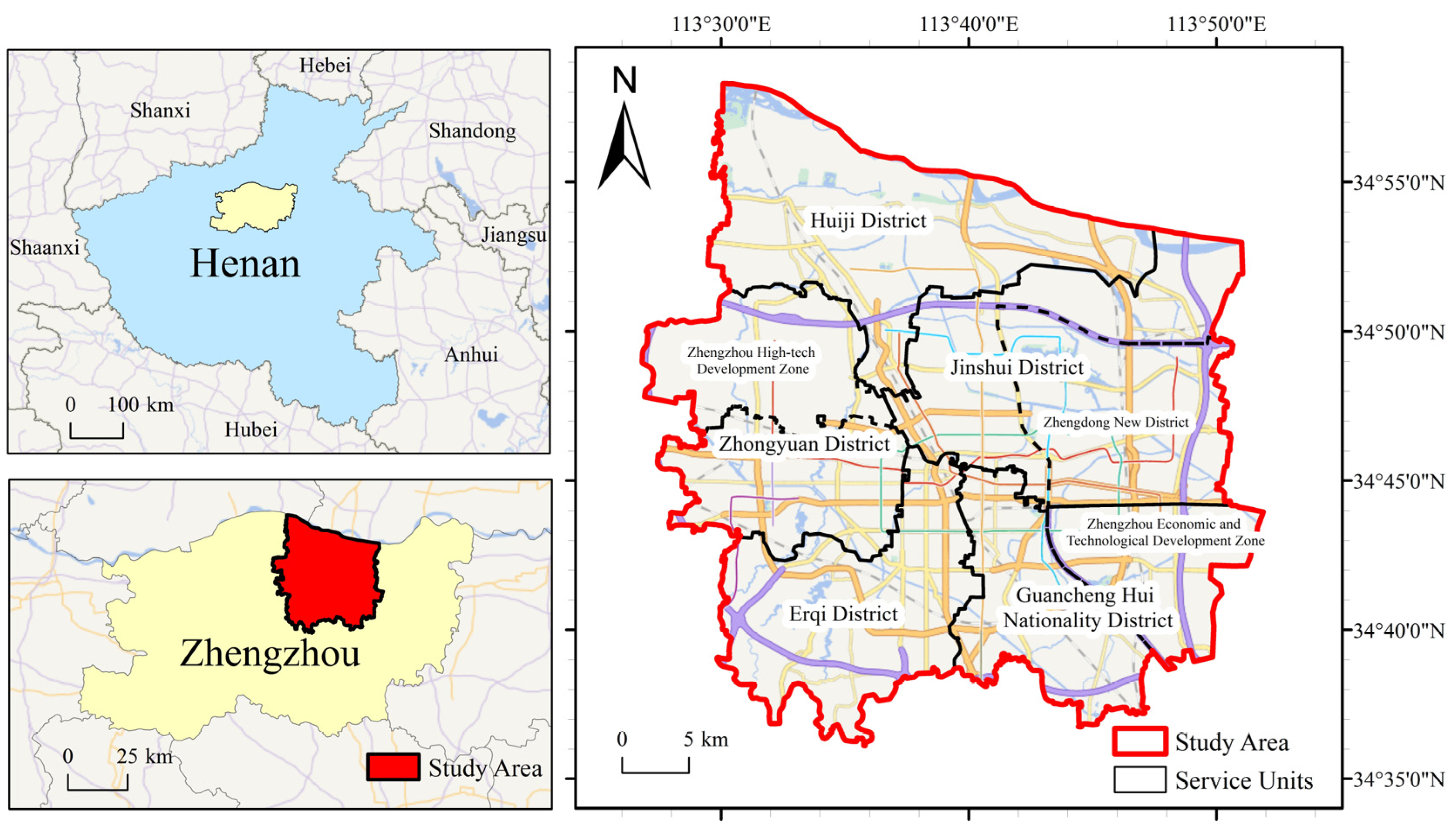


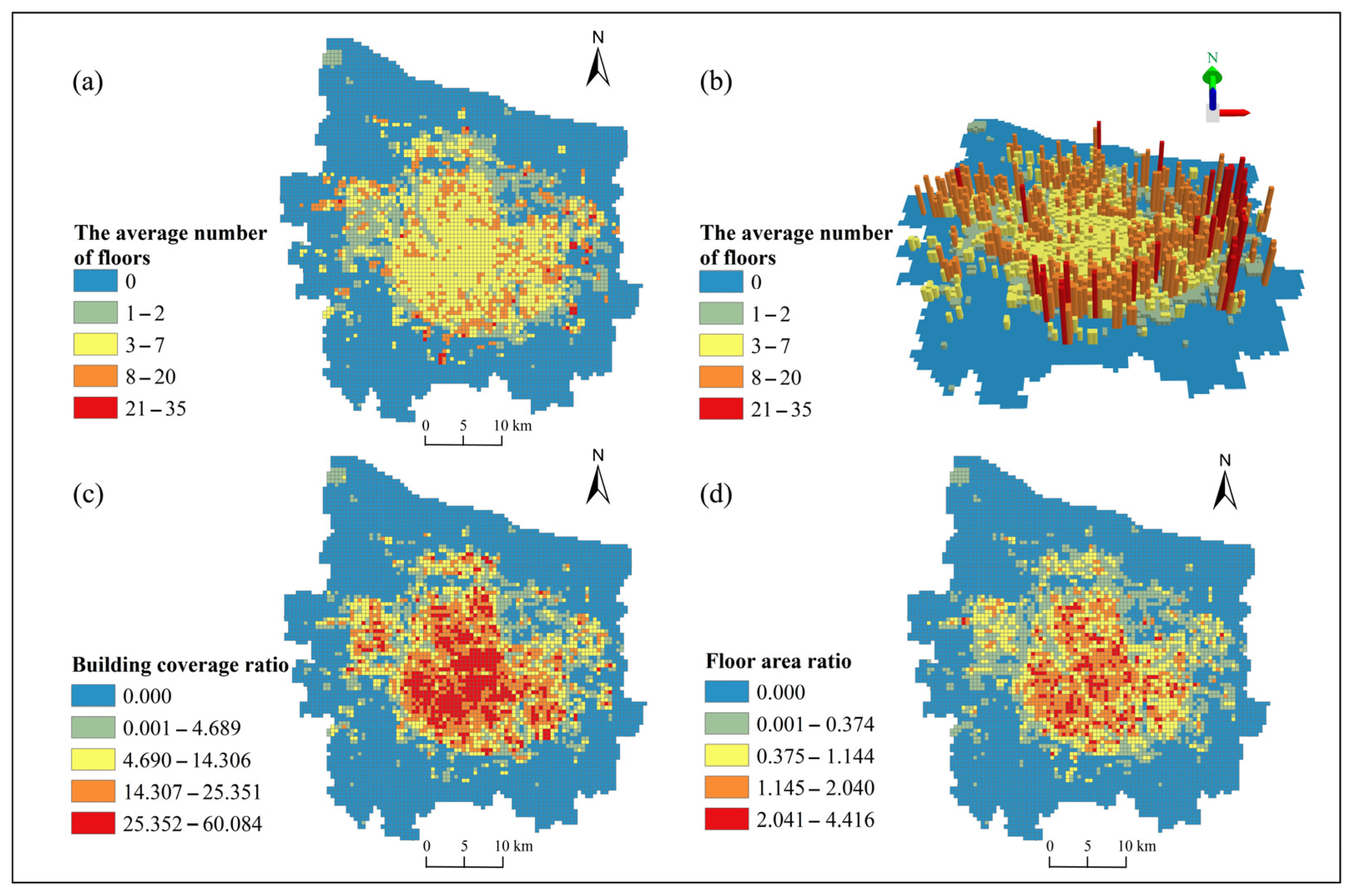

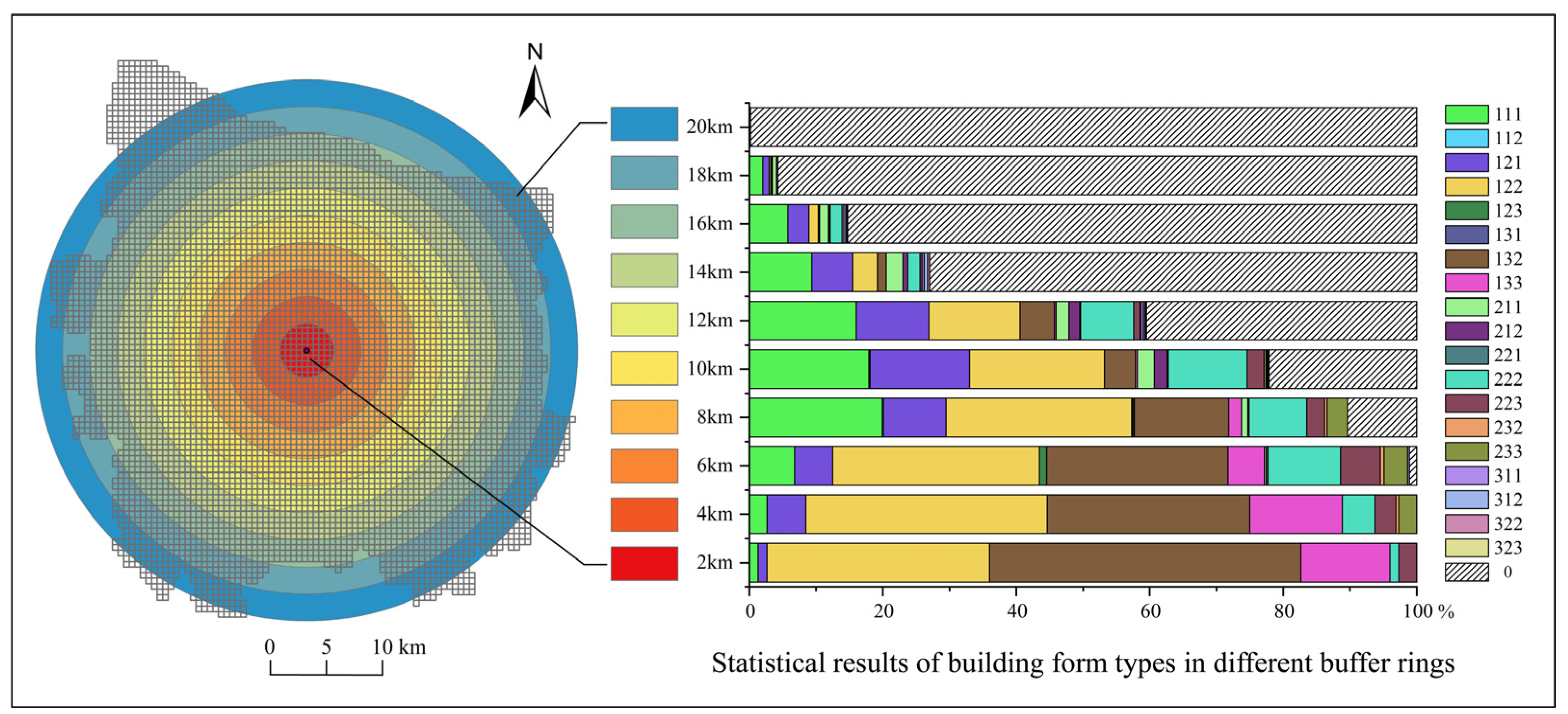
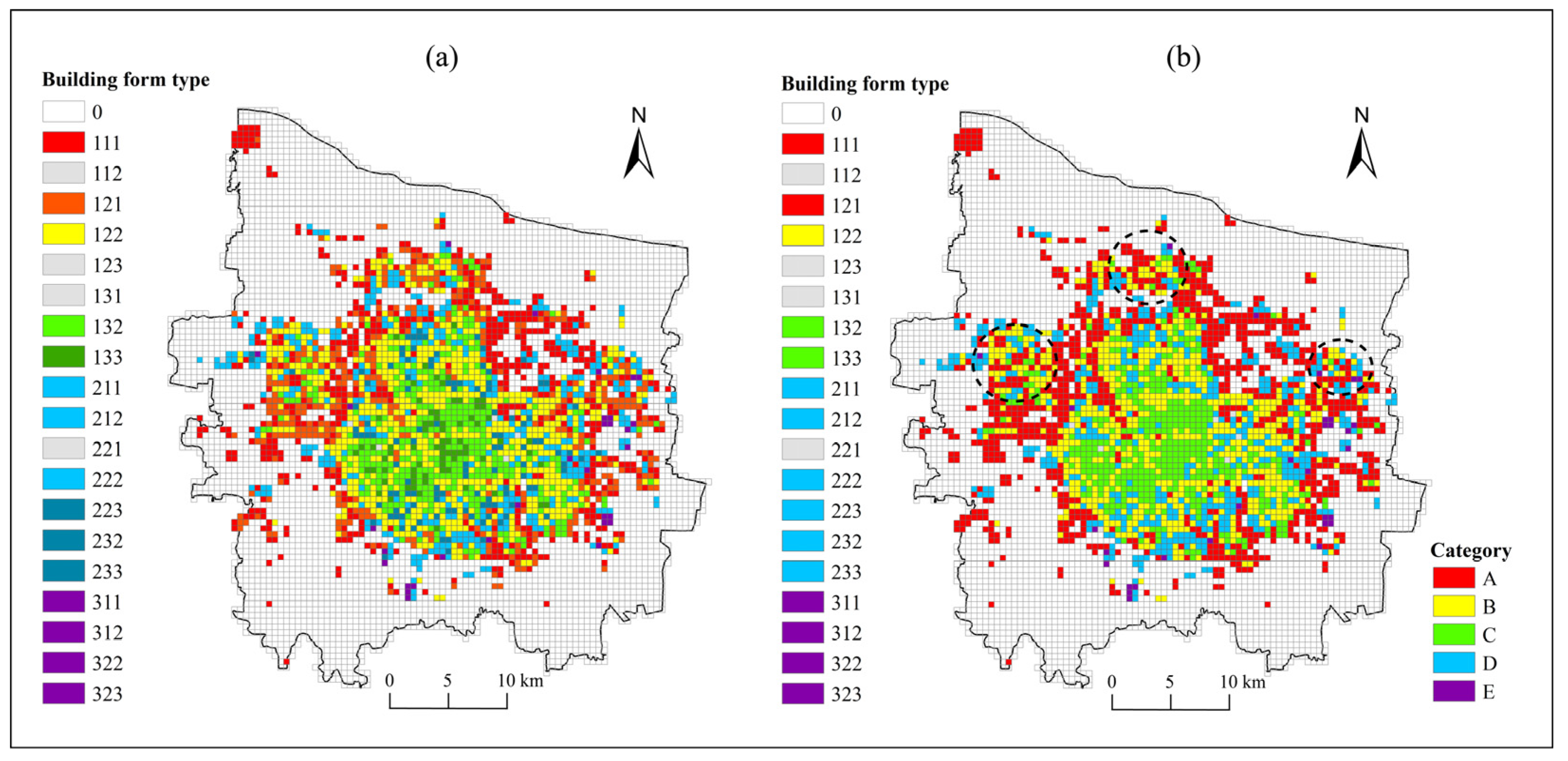
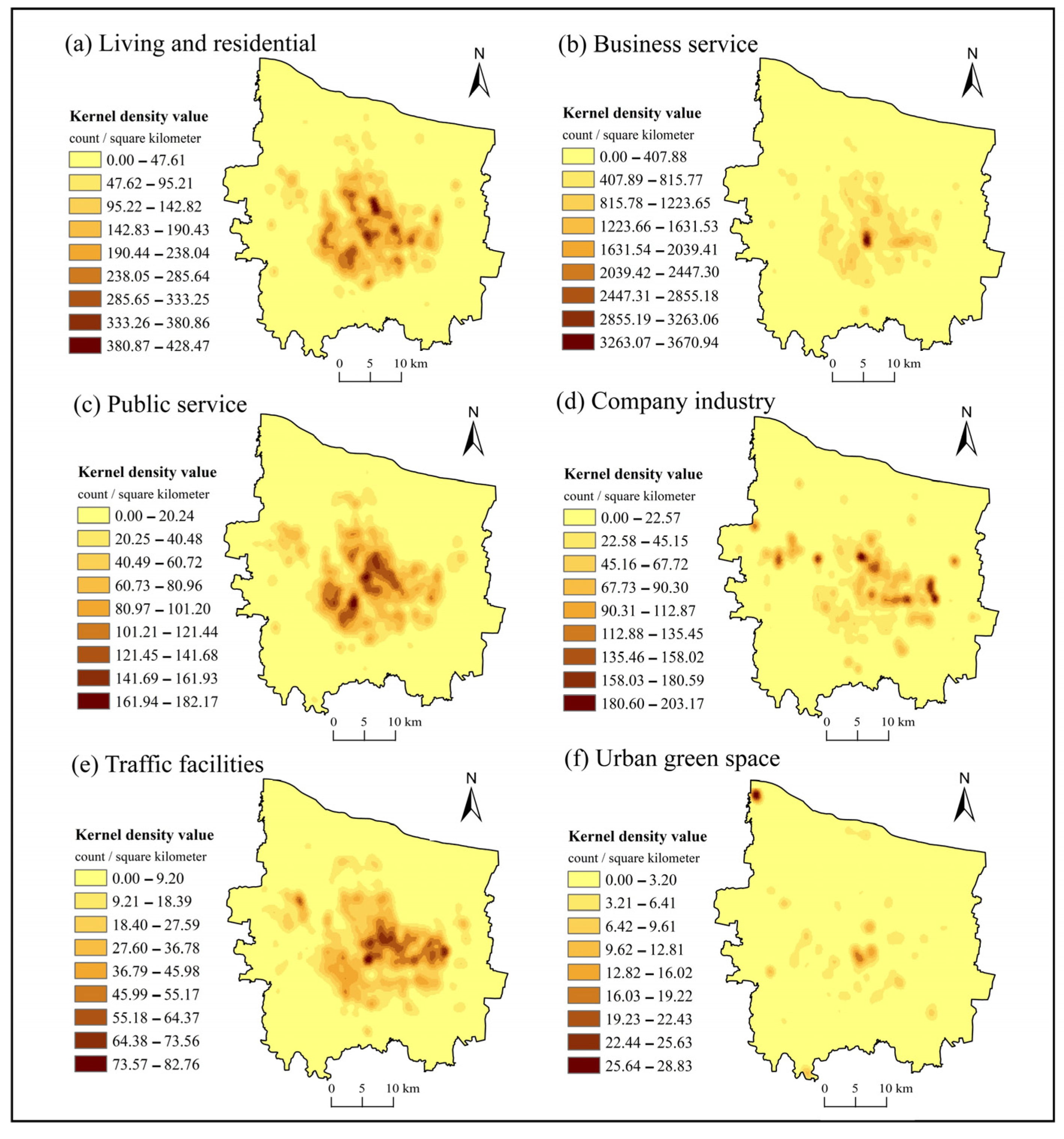
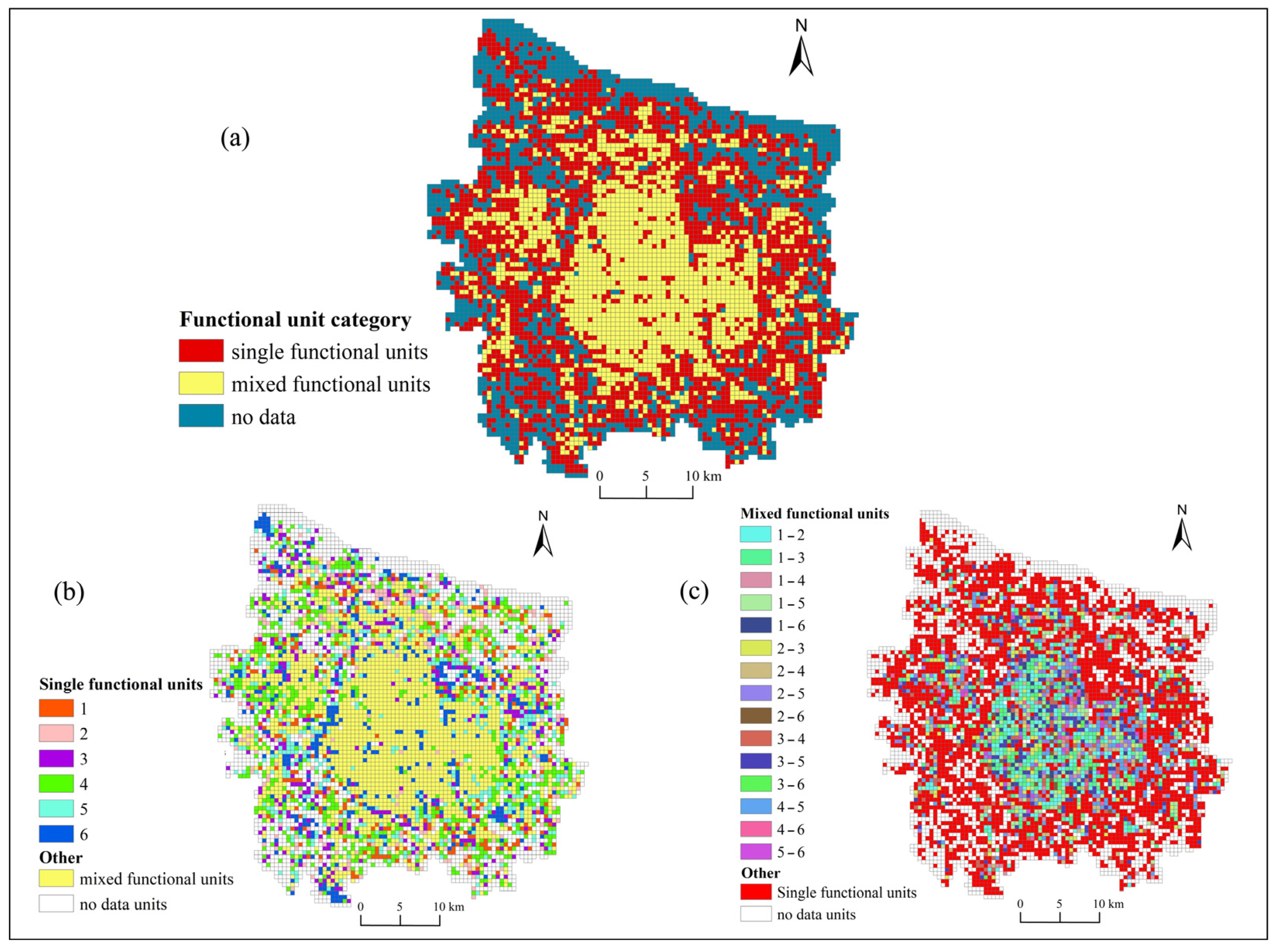
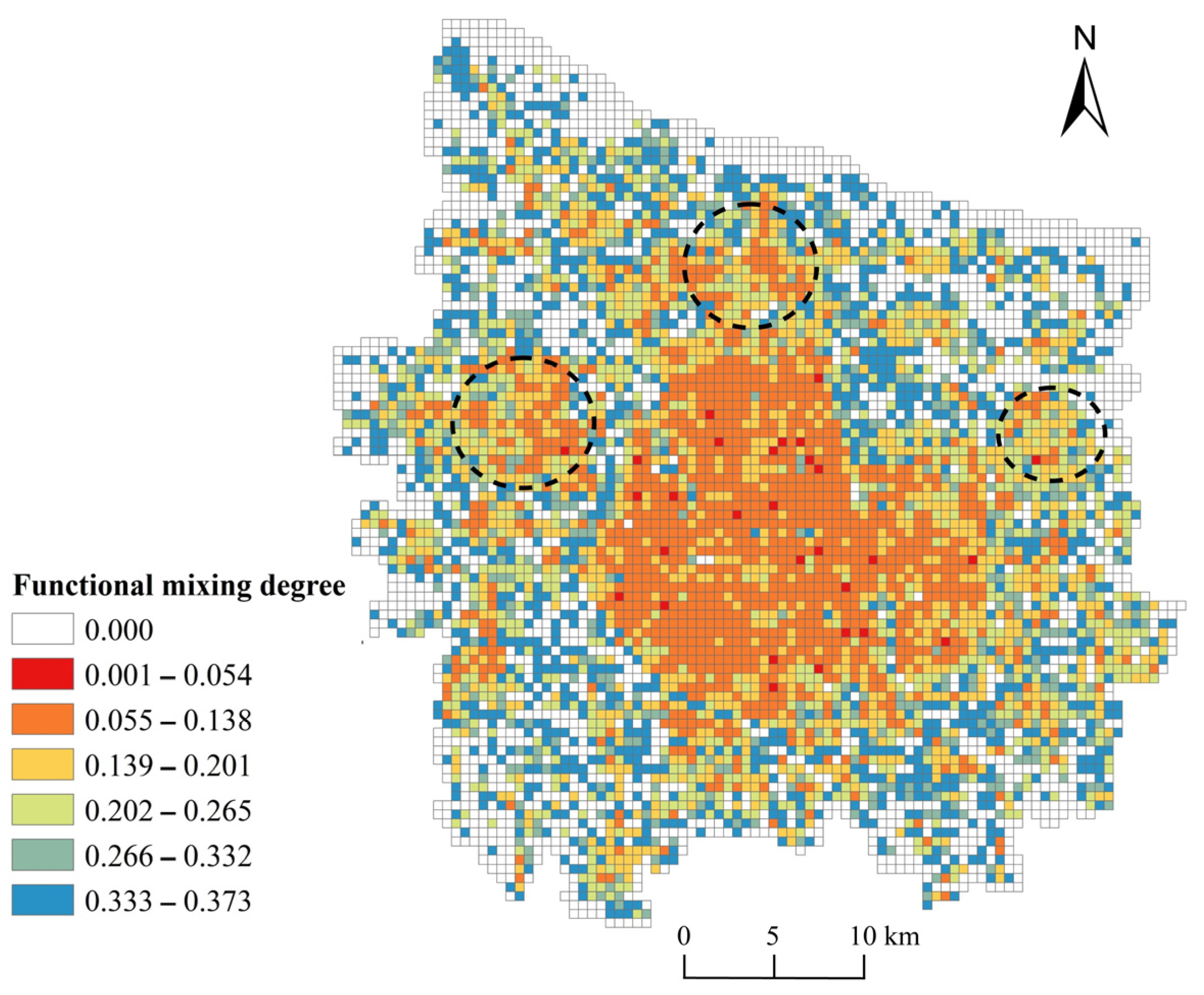
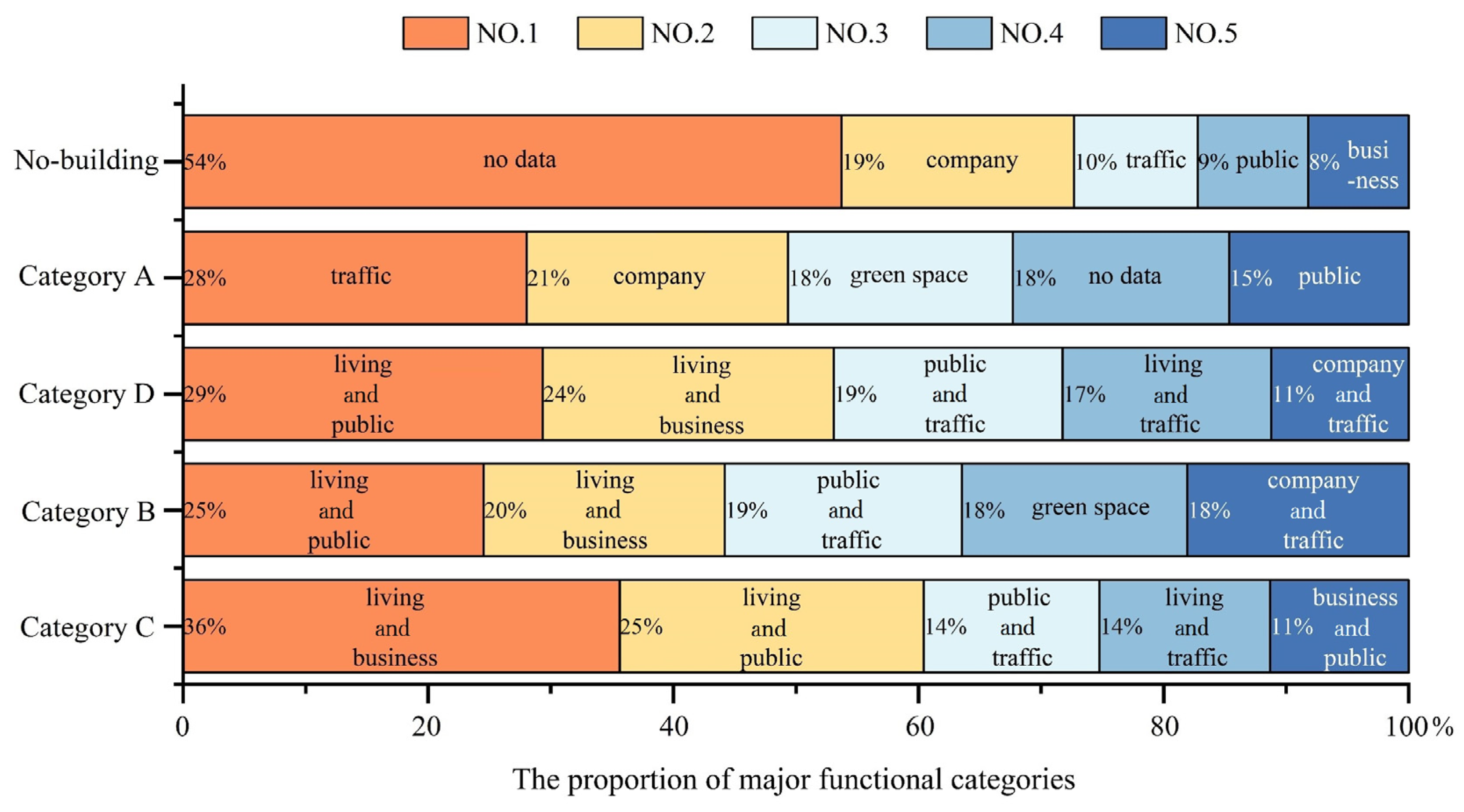
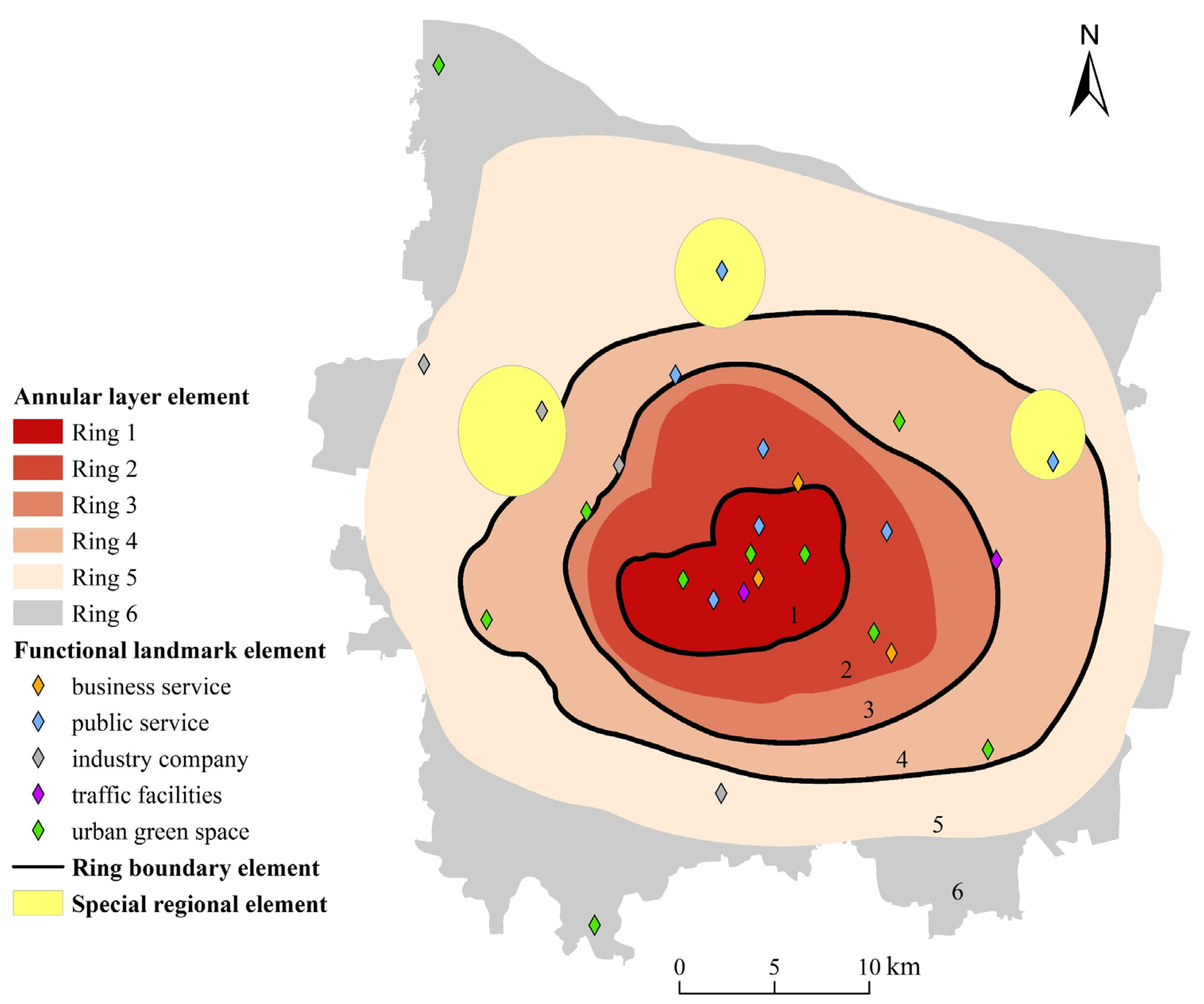
| Functional Category | Main Class | Description | Number (Unit) | Proportion (%) |
|---|---|---|---|---|
| Living and residential | Commercial residence | Residential area, dormitory, villa, etc. | 8554 | 16.68 |
| Life service | Barbershop, logistics center, bathing center, etc. | 61,304 | ||
| Business service | Catering | Chinese restaurant, snack shop, fast food restaurant, etc. | 95,974 | 66.02 |
| Shopping consumption | Market, mall, supermarket, etc. | 144,124 | ||
| Hotel accommodation | Hotels, homestays, etc. | 12,444 | ||
| Automobile industry | Car repair shop, gas station, etc. | 19,854 | ||
| Leisure and entertainment | Cinema, KTV, Internet bar, etc. | 4238 | ||
| Public service | Financial institution | Banking, insurance agency, etc. | 2976 | 7.76 |
| Education industry | Library, school, etc. | 14,059 | ||
| Medical care | General hospital, clinic, pharmacy, etc. | 10,674 | ||
| Sports and fitness | Gymnasium, swimming pool, etc. | 2694 | ||
| Public toilet | Public toilet | 2094 | ||
| Industry company | Business | Company, factory, farm, etc. | 21,961 | 5.62 |
| Industrial park | Science and technology park, incubation park, etc. | 464 | ||
| Business building | Office buildings, industrial buildings | 1113 | ||
| Traffic facilities | Transportation facilities | Bus station, car park, train station, etc. | 15,326 | 3.66 |
| Urban green space | Tourist attraction | Parks, squares, scenic spots, etc. | 1079 | 0.26 |
| 418,932 | 100.00 |
Disclaimer/Publisher’s Note: The statements, opinions and data contained in all publications are solely those of the individual author(s) and contributor(s) and not of MDPI and/or the editor(s). MDPI and/or the editor(s) disclaim responsibility for any injury to people or property resulting from any ideas, methods, instructions or products referred to in the content. |
© 2024 by the authors. Licensee MDPI, Basel, Switzerland. This article is an open access article distributed under the terms and conditions of the Creative Commons Attribution (CC BY) license (https://creativecommons.org/licenses/by/4.0/).
Share and Cite
Zhou, X.; Li, H.; Xu, J.; Sun, Q. Urban Spatial Image Acquisition and Examination Based on Geographic Big Data. Land 2024, 13, 774. https://doi.org/10.3390/land13060774
Zhou X, Li H, Xu J, Sun Q. Urban Spatial Image Acquisition and Examination Based on Geographic Big Data. Land. 2024; 13(6):774. https://doi.org/10.3390/land13060774
Chicago/Turabian StyleZhou, Xiaowen, Hongwei Li, Jian Xu, and Qingzhen Sun. 2024. "Urban Spatial Image Acquisition and Examination Based on Geographic Big Data" Land 13, no. 6: 774. https://doi.org/10.3390/land13060774






